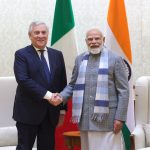
 The first-ever reference to South China Sea in an India-US joint statement during Prime Minister Narendra Modi’s trip to Washington has riled Beijing, and revived the latter’s fears about the world’s two largest democracies acting in concert on a larger China containment strategy.
The first-ever reference to South China Sea in an India-US joint statement during Prime Minister Narendra Modi’s trip to Washington has riled Beijing, and revived the latter’s fears about the world’s two largest democracies acting in concert on a larger China containment strategy.
Predictably, China, which, according to the IMF, has taken over the US to become the world’s largest economy on purchasing power parity terms, has asserted that the South China Sea sovereignty issue should be resolved directly by parties concerned and without meddling from any third party.
“Our position is that the dispute in the South China Sea should be resolved by countries directly concerned through negotiations and consultations. Any third party should not be involved in this,” Chinese Foreign Ministry spokesman Hong Lei said in Beijing October 8.
The spokesperson was reacting to the Indo-US joint statement issued after Mr Modi’s maiden summit meeting with US President Barack Obama on September 30 which underlines the need for freedom of navigation and calls for resolving the South China Sea dispute according to the UN Law of the Sea.
Beijing’s reaction was, however, cautious and more in the nature of a reiteration of its oft-stated position on the South China Sea, which is claimed by Beijing and four Southeast Asian countries, including Vietnam, the Philippines, Malaysia and Brunei besides Taiwan.
“The leaders expressed concern about rising tensions over maritime territorial disputes, and affirmed the importance of safeguarding maritime security and ensuring freedom of navigation and over flight throughout the region, especially in the South China Sea,” said the September 30 India-US joint statement.
“The Prime Minister and President called on all parties to avoid the use, or threat of use, of force in advancing their claims. The two leaders urged the concerned parties to pursue resolution of their territorial and maritime disputes through all peaceful means, in accordance with universally recognized principles of international law, including the United Nations Convention on the Law of the Sea,” said the statement.
The Chinese political and diplomatic establishment closely watched the Indian prime minister’s first visit to the US which rejuvenated and buttressed strategic and economic partnership between the world’s two largest democracies. Beijing has been apprehensive of the growing proximity between India and the US and has often suspected Washington of using New Delhi as part of a larger China containment strategy. In this context, Beijing has warily watched the growing defence partnership between India and the US on the one hand and the plan to elevate the India-US-Japan trilateral dialogue to the level of foreign ministers.
Much to the discomfort of Beijing, India’s Act East policy and the US rebalance to Asia are converging in some respects to promote peace and stability in the Asia-Pacific theatre.
In an oblique response to China’s maritime silk road initiative, the US has proposed its New Silk Road and India-Pacific Economic Corridor, and is trying to enlist India in creating a seamless flow of commerce and energy in the region.
The latest summit meeting between the leaders of India and the US have resurrected Beijing’s old anxieties about Washington’s containment strategy. The new Modi government in Delhi has, however, made it clear that it is not into zero sum games, but is looking to maximize its development options by bolstering closer ties with the US, Japan and China on separate tracks.
Author Profile

- Manish Chand is Founder and Editor-in-Chief of India Writes Network (www.indiawrites.org) and India and World, a pioneering magazine focused on international affairs. He is CEO, Centre for Global India Insights, an India-based think tank focused on global affairs.
Latest entries
 India and the WorldDecember 12, 2025India-Italy bonding: Tajani’s visit raises the bar for business, maritime ties
India and the WorldDecember 12, 2025India-Italy bonding: Tajani’s visit raises the bar for business, maritime ties In ConversationNovember 26, 2025G20 is a Force for global Good
In ConversationNovember 26, 2025G20 is a Force for global Good articlesNovember 26, 2025Rescuing G20 from North-South divide: Ubuntu Moment
articlesNovember 26, 2025Rescuing G20 from North-South divide: Ubuntu Moment India and the WorldOctober 27, 2025Modi hails the century of India and ASEAN, backs ASEAN centrality
India and the WorldOctober 27, 2025Modi hails the century of India and ASEAN, backs ASEAN centrality







